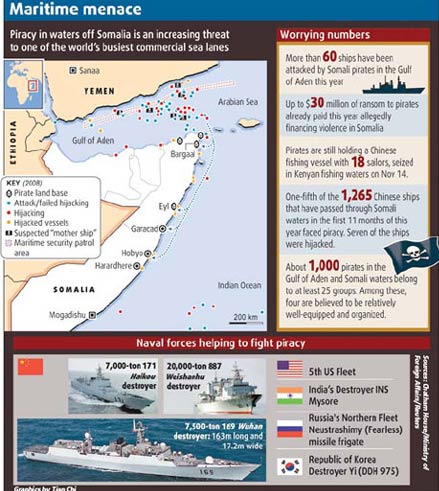
|
CHINA> National
 |
|
Sailing to strengthen global security
By Wu Jiao and Peng Kuang (China Daily)
Updated: 2008-12-26 08:35
 Maintaining smooth coordination and cooperation with other navies in surrounding areas also remains a major obstacle for China's fledgling navy, Peng said. "The upcoming naval deployment in the pirate-infested waters off the Somali coast will bring the Chinese navy to the forefront of unprecedented challenges and difficulties," he said.
"A small-scale battle is more real than large drills," he said, adding that taking part in such missions on the international level will accelerate the reform of the Chinese navy. While the country has followed an inshore defense naval strategy, the decision to send out a fleet far beyond its borders has also provoked wide speculation from the international community on its intentions behind the move. Foreign media agencies said China aims to build a "blue-water navy" - alluding to the activities that symbolize naval might typified by fleets of US and Russian aircraft carriers - through the current mission. In a recent report by The Washington Post, the newspaper compares the Somali mission to the efforts made by Chinese naval pioneer Zheng He. The fleet of Zheng He in the Ming Dynasty (1368-1644 AD) consisted of enormous nine-mast junks, supply ships, water tankers, patrol boats and more than 27,000 sailors and soldiers, who allegedly defeated major pirates in Somali waters then and completed several epic voyages. "That harkens back to Zheng He, the Ming Dynasty court eunuch who commanded a fleet of vessels that crossed the Indian Ocean and made it to the coast of East Africa (and maybe beyond)," the paper said, while AFP reported that "the decision is both historic and could have far-reaching consequences". Other media also said the mission has caused "anxiety" among its Asian neighbors Japan and India. Japan and South Korea do not have aircraft carriers but are considered to possess significant naval strength including battleships that can carry aircraft. India also has an aircraft carrier, large-scale destroyers and nuclear submarines. China's naval power is relatively weak in this regard, analysts said. Naval activities on such a global scale require comprehensive capabilities that include adequate logistics, intelligence activities and strong communication networks. As such, the country's naval activities have so far been limited to maritime exchanges with its nascent navy. In 2002, a Chinese fleet made its inaugural round-the-globe trip, lasting four months and 30,000 nautical miles. However, the Chinese navy has so far primarily focused on defending the country's coastal security and limited its overseas operations to port calls, goodwill visits and exercises with other navies. The country's naval strategy will still focus on off-shore defense and its navy cannot be considered a blue-water navy, Peng said. But that does not mean China cannot venture outside the near seas, he said. "Possessing the power of pelagic maneuvering does not contradict our near-sea defense policy. It should further develop to act as a vanguard of the country's modernization program," Peng said.
|
|||||